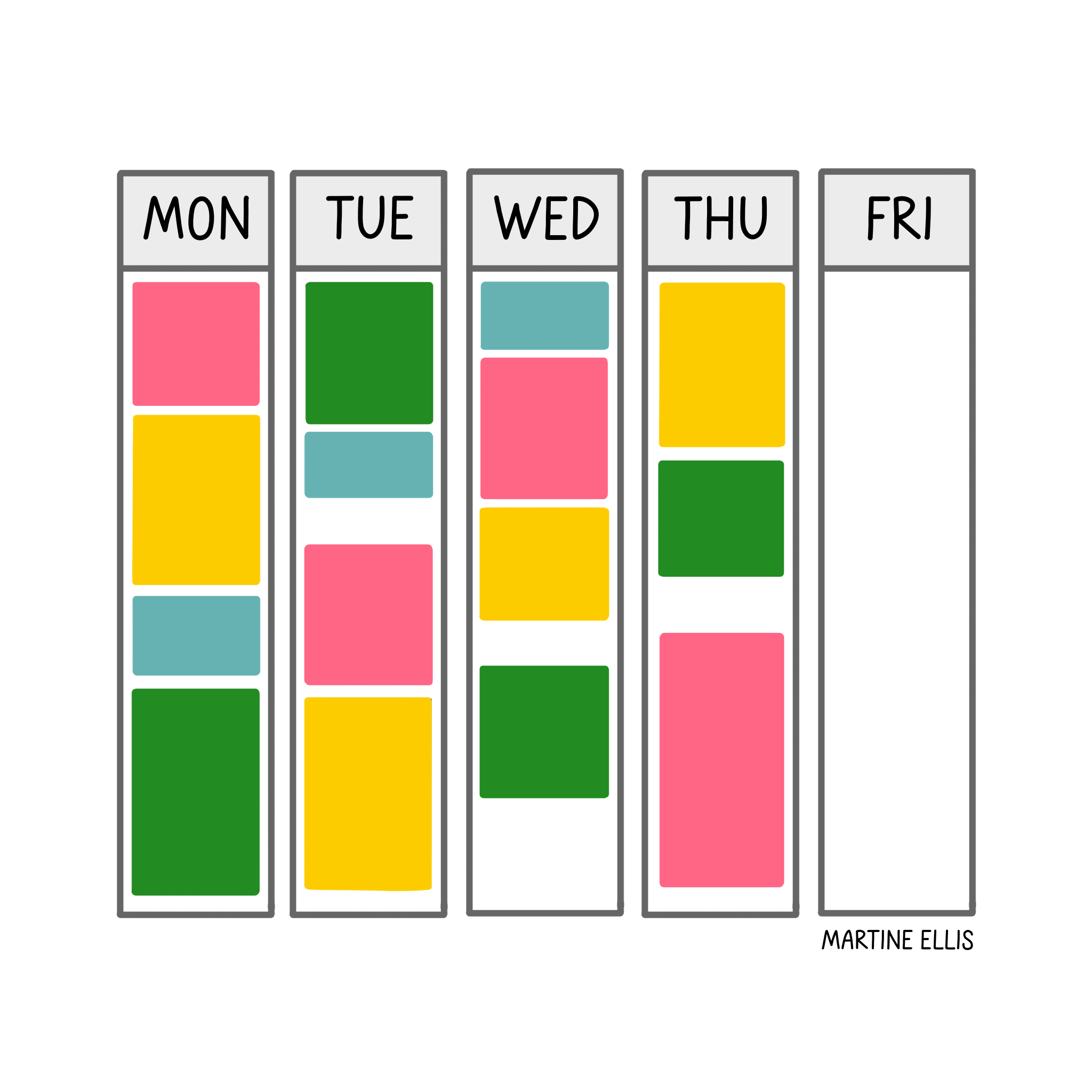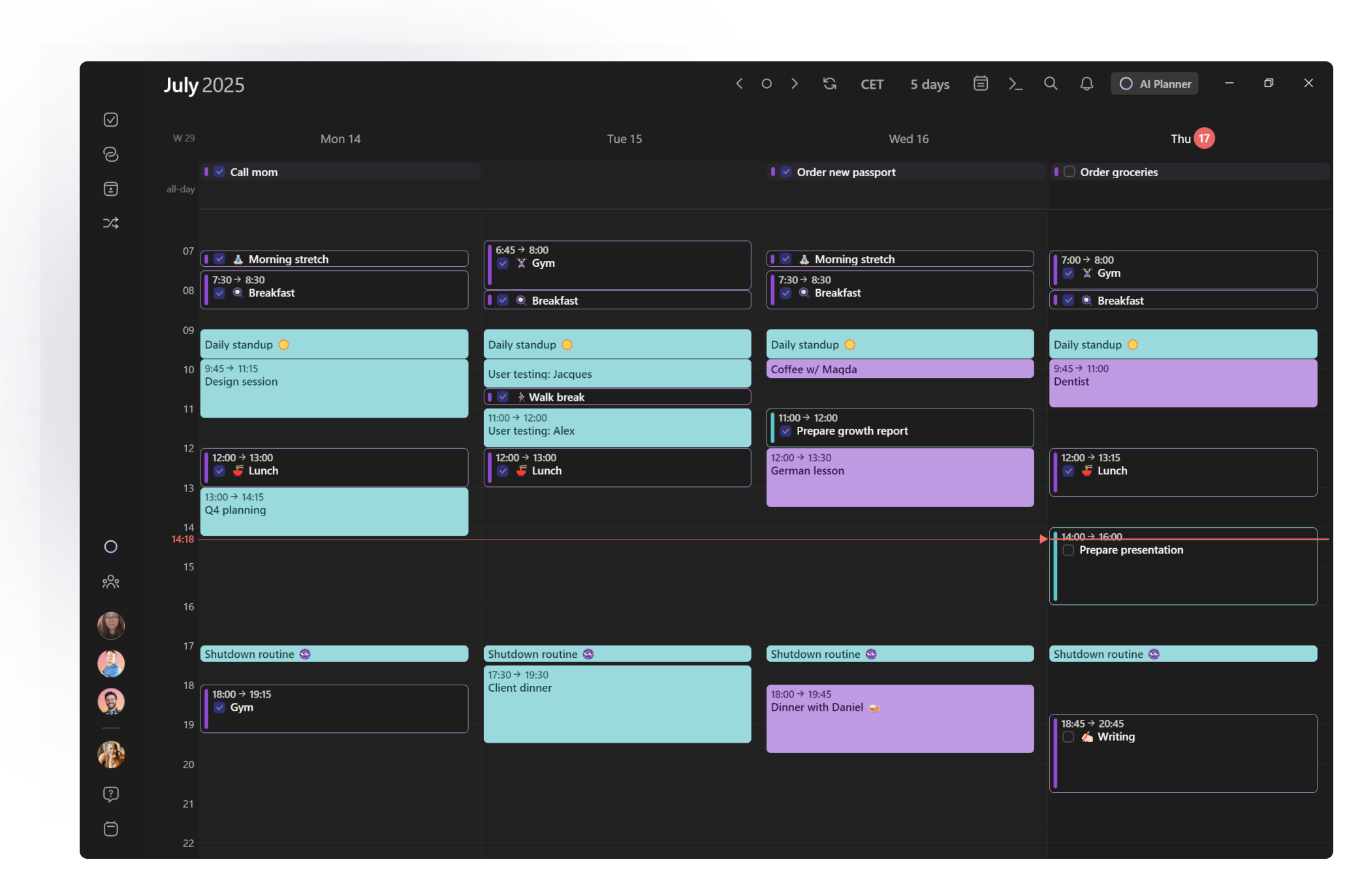The cost of meetings on tech team’s flow
%20(32).png)
How to Fix Fragmented Time
Meetings Are Breaking Your Focus
When I asked dozens of Morgen users how meetings affect their productivity, I saw the same reaction over and over: a sigh and an eye roll.
Some were frustrated by the sheer number of meetings. Others felt their time was wasted on low-value ones. But there was one pain point everyone shared that went beyond the number of meetings. It was the timing of the meetings that mattered most. Meetings scattered across the day slice their focus into tiny, unusable pieces.
The rise of remote work has made this worse. Software teams now spend roughly a third of their week in meetings. That’s a lot, but the bigger problem is what those meetings do to the rest of your time.
Why Fragmented Time Hurts So Much
On average, it takes 23 minutes to refocus after switching tasks. If your day is chopped into 40-minute or 1-hour chunks between meetings, you rarely reach the deep-focus state where meaningful work gets done.
Imagine an 8-hour day with three team meetings:
- Scenario 1: Meetings from 9–12 PM (afternoon free for deep work)
- Scenario 2: Meetings from 1–4 PM (morning free for deep work)
- Scenario 3: Meetings from 9–10 AM and 3–5 PM (midday block for deep work)
- Scenario 4: Meetings at 10–11 AM, 1–2 PM, and 3–4 PM (no more than 40–60 minutes between interruptions)
Scenarios 1–3 leave room for 2+ hour blocks of focus time. Scenario 4, the “Swiss cheese schedule”, destroys it entirely.
For engineers, designers, writers, and those in other maker roles, this fractures focus time, directly reduces productivity, output quality, and job satisfaction.
How to assess your engineering team’s fractured time
It’s widely accepted by engineering teams and managers that flow time makes them more productive. This time for deep work is crucial to engineers’ productivity, effectiveness and satisfaction, yet few teams have processes to maximize it.
Keeping an eye on total time spent in meetings is helpful, but fails to paint the full picture. Instead, leaders should assess the percentage of time their teams spend in:
- Flow (uninterrupted 2+ hour blocks of time)
- Friction (time blocks that are <2 hours between meetings)
- Meetings
- Overflow (time outside of working hours completing tasks)
These metrics, when considered together, will help leaders and teams identify how their meeting schedules impact overall productivity.
Where AI scheduling addresses the fragmentation problem
Traditional calendars show availability but don't actively protect productive time or adapt to changing priorities. This is why teams fall into fragmentation patterns despite good intentions.
Your schedule should be a unified picture of your day that updates dynamically throughout the day, protects deep work time, and makes meetings fit around your priorities.
Smart schedulers like Morgen use AI to transform meeting blocks into context-aware time slots that adapt to your tasks, focus blocks, and availability.
Protect Flow Time:
- Block your focus time: Create Frames to dedicate your most productive time to deep work on tasks, set them as busy, which leaves other times in the day open for meetings.
- Energy-aware AI: Ensure your AI planner bases your schedule on your energy levels. So if you have a cluster of meetings in the afternoon, you can set your Frames for low-energy work and use the AI to schedule lighter tasks that won't drain your focus too fast.
Reduce Friction:
- Cross-platform integration: Merge calendars and tasks from multiple tools into one source of truth and schedule your tasks in one view. Scattered tasks and events make it harder to plan for uninterrupted time and allocate time for meetings.
- Smart meeting windows: Share your availability with specific time slots that batch meetings together, preventing the "Swiss cheese schedule" problem.
Coordinate with your team:
- Share your availability: Share your schedule visibility with your team. When your team's aware of your plan, meetings can be planned more effectively around collective focus blocks.
- Multiple meeting slots: Use Open Invite as a simple, one-time scheduling link that lets you propose available time slots, cross-checking your availability against any time blocked tasks and frames marked as busy.
Manual scheduling vs. AI scheduling: Impact on fragmentation
How to align with your team to fix fragmentation
AI tools work best when combined with deliberate team practices. By default, when scheduling meetings, most of us simply look for an open spot in the calendar and send out the invite. We consider personal convenience but rarely optimize for collective maker time.
The mindset shift: Treat team energy and focus time as shared resources that require intentional protection, just like you'd protect shared technical infrastructure.
Align team 1:1s
Managers tend to stack 1:1s with their direct reports back-to-back at the same time every week. While this minimizes their own calendar fragmentation, it doesn't account for their team members' time. Since these meetings happen often, usually weekly or bi-weekly, the repeated cost of fragmenting the team's time adds up. Instead, 1:1s should be scheduled in a way that maximizes collective maker time, perhaps being scheduled over multiple days or always set at the start or end of the workday.
Increase team awareness of everyone’s schedules
Scheduling links are great for external meetings, but when it comes to internal meetings, teams should have visibility into one another’s calendars. Everyone can then strive to book meetings in a way that maximizes team-focused time. Team members should be encouraged to change or propose alternate meeting times when they see maker time being fractured.
Piggyback on other meetings
Last-minute meetings happen. About 20% of engineering teams’ meetings are scheduled with less than 24 hours' notice. Ideally, these should be slotted right before or after another meeting involving the team, or at the beginning or end of the day.
Add a meeting-free day
Meeting-free days are becoming more prevalent as a way to protect focus time and encourage async communications.
TLDR step-by-step: How to fix time fragmentation
- Unify your picture - Connect all calendars + task tools so you see one schedule.
- Protect deep work with energy Frames - Mark your high-energy hours for focus. Keep them meeting-free. Leave lower-energy windows open for meetings.
- Offer smart meeting options - Use Morgen’s Open Invite to propose details + multiple slots so others pick what fits.
- Share availability - Let teammates see your plan so they can book around your focus blocks (and you around theirs).
- Batch your task time - Create frames like “Deep Work,” “Admin,” “Linear tasks.” Let AI auto-fill each frame with matching tasks.
- Make AI energy-aware - Tell the planner your energy pattern; if afternoons are meeting-heavy, schedule lighter tasks there.
- Adapt continuously - When meetings move or clash, have the AI reshuffle tasks and keep deep-work frames intact.
- Team norms to reduce fragmentation - Encourage proposing alternate times if someone’s focus block is getting cut up.
- Weekly tune-up (fast) - Review next week’s frames, meeting windows, and availability sharing; adjust once so daily plans stay smooth.
The payoff
Fragmented time doesn’t just make you less productive. It drains your energy and forces you to make up for lost hours at night or on weekends.
By combining deliberate team meeting habits with AI-driven task scheduling in Morgen, you protect your focus, align your work with your natural energy, and finally get the uninterrupted time you need to do your work.
Your calendar is already full. The question is: will it keep you reactive, or will it work for you?
Frequently asked questions about fragmented time & AI scheduling
What is fragmented time at work?
Fragmented time is when your day is broken into small, disconnected chunks between meetings, creating interruptions. These gaps are usually too short for deep work, leading to lost productivity and energy.
How does fragmented time affect productivity?
It takes an average of 23 minutes to refocus after a context switch. If your calendar is full of scattered 30–60 minute blocks, you rarely reach a state of deep focus.
How can I reduce fragmented time in my schedule?
Start by blocking deep work, then schedule 1:1s where they won’t interrupt your focus. With Morgen, meeting links only open during your chosen windows, while smart scheduling keeps tasks organized, so your priorities stay protected and your day flows without friction.
What is an AI scheduling tool?
An AI scheduling tool is software that dynamically adjusts meeting time windows and organizes tasks based on your availability, priorities, and energy levels. Unlike traditional calendars, it actively protects deep work and adapts to changes in your day.
How does Morgen compare to Google Calendar or Outlook?
While Google Calendar and Outlook show availability, Morgen goes further by helping you protect focus blocks, batch tasks, adapt to your energy levels, and unify your calendar view across all tools.
.png)
.webp)

